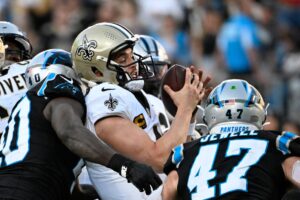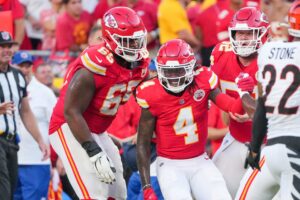The 2018 season began practically the same way it ended for the Atlanta Falcons. With a chance to win the game with a touchdown, the offense stalled inside the 10-yard line. Making it even worse, it happened in the same stadium — even the same end zone. The Falcons experienced red-zone issues all night against the Philadelphia Eagles, tallying just one touchdown on five trips inside the Eagles 20-yard line. That was a major reason the Falcons lost to the defending champions, 18-12. After the frustrating loss, several were wondering why Atlanta wasn’t targeting Julio Jones in the red zone more often.
Red zone issues are nothing new for the Falcons. A season after finishing eighth in red-zone touchdown percentage, the Falcons dropped to 23rd in the category last season. In 2017, they reached the end zone on less than half of their red zone possessions, and nothing in Week 1 suggests that scoring within the red zone will be any easier for quarterback Matt Ryan and company this fall.
Changes need to be made, but forcing the ball to All-Pro wide receiver Julio Jones isn’t the answer.
Targeting Julio Jones in the Red Zone Won’t Solve Falcons’ Struggles
Standing at 6-foot-3 and 220 pounds, one would think Jones would be an excellent red-zone target. He possesses great hands and jumping ability, making him a prime weapon for fades and jump balls.
But for whatever reason, that has never materialized during his career.
Even in 2016 when the Falcons led the league in scoring and finished eighth in red-zone offense, Jones had only six touchdowns. And just two of those scores came on passes from inside the 20-yard line.
In his eight-year career, Jones has hauled in 43 touchdowns, 18 of which (or 41.9 percent) have come on passes in the red zone. Compared to Antonio Brown, who became a starter during Jones’ rookie season in 2011, the Pittsburgh Steelers wideout has 60 touchdowns, 31 of which are from the red zone (or 51.7 percent).
Brown is an all-world talent, but Jones is the taller, bigger receiver, so it doesn’t really make sense that Brown has more red-zone touchdowns and scores overall. Stats don’t lie, though, and the last time Jones recorded more than two touchdowns from inside the red zone was 2015.
Atlanta Falcons Red Zone Struggles with Julio Jones
The most obvious reason for why Jones isn’t finding the end zone enough would be because Ryan isn’t targeting his best receiver near the goal line. Sometimes that’s the case, but it hasn’t really been recently.
In 2017, Ryan targeted Jones 19 times in the red zone. That’s actually one more time than Brown, who the Steelers threw to 18 times inside the opponent’s 20-yard line last year. So Jones is receiving his opportunities.
But Jones caught just five of those 19 attempts in 2017. That’s a catch percentage of 26.3 percent, which is less than half of what his catch percentage was on plays everywhere else on the field. Plus, only one of his five red-zone receptions ended in a touchdown last year.
Clearly, trying to get Jones the ball isn’t the problem, and feeding it to him unnecessarily is going to be counterproductive as it was Thursday. On the final set of downs against the Eagles, the Falcons ran five plays inside the 10-yard line, and on two of them, Ryan targeted Jones despite the fact he was either double covered or too close to being out of bounds.
On the other three plays, Ryan didn’t target anyone in particular, throwing the ball away.
Spreading the Ball Around Key to Falcons Solving Red-Zone Offense
“Take what the defense gives you” is a cliche for a reason, and it’s what the Falcons need to begin doing close to the end zone.
In some cases, such as the final drive Thursday night, there’s no one open, which doesn’t leave much for the Falcons “to take”. But keeping Jones as the primary read when it’s clear at the line of scrimmage that he’s receiving double coverage isn’t the answer either.
The Falcons have other talented weapons on offense. Devonta Freeman and Tevin Coleman make up a running back duo capable of giving the Falcons a ground attack near the goal line (although that also didn’t work early against the Eagles).
If defenses double Jones and take care of the running game, fellow wide receiver Mohamed Sanu is almost certainly one-on-one with the opponent’s second-best cornerback. Sanu has to win that matchup.
Another option is tight end Austin Hooper, who is as tall as Jones and more than 250 pounds. At the very least, he can box out linebackers in the end zone.
Once defenses have to worry about other players in the scoring area, Jones won’t be receiving double coverage anymore. It’s up to the other Falcons weapons to make plays and loosen the coverage on their star.
But if Jones continues to be the team’s main source of offense like he was Thursday – he posted 180 of Atlanta’s 299 yards – then the team is going to continue to struggle in the red zone.
And feeding him the ball when the coverage doesn’t allow it won’t help at all.
Main photo:
Embed from Getty Images






